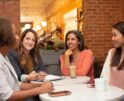
Welcome to the Matrix

There are 76 million reasons to update your office for Gen Y.
By Diane K. Danielson
“The Millennials are coming, the Millennials are coming!” shouts Barbara Boomer to her HR staff as she races to her office to brace herself for what she’s sure will be an endless onslaught of iPod-toting, flip-flop wearing, IM-ing, twentysomething employees, each with an insatiable desire for instantaneous feedback and the ability to text message “helicoptering” parents to swoop in and lobby on their overachieving, entitlement-believing, attention-demanding behalf.
Like Barbara, for many of us the thought of managing or even working alongside Generation Y – or “Millennials,” as the youngest members of Generation Y prefer to be called – can trigger a multigenerational panic attack of Steinbeck-worthy proportions. Who are these teens and twentysomethings running amok in our midst? If we choose to ignore them, will they eventually go away? Or, better yet, will they have to accept the traditional hierarchy and command-and-control leadership of corporate America?
If any of these questions have recently crossed your mind, keep reading, as there are 76 million reasons why you and your company cannot afford to think that way for another nanosecond.
The Times (and the workforce) They Are A-Changing’
As a member of Generation X (the often ignored and arguably mislabeled slacker generation of no statistical consequence), I’m accustomed to following the baby boomers’ lead in the office. If the company says donate to this charity, I donate. If it takes 10 years to scale the corporate ladder, I will try to do it in nine, even if I have to work every weekend from now until 2015. However, as the boomers retire over the next decade, I’ll likely have to follow the beat of a different drum. It’s becoming increasingly difficult to ignore the 76 million Millennials currently entering the workplace, as they match the boomers not only in size but also in their desire to remake the corporate world in their own image.
My fascination with Millennials began last year during a Q & A session after a speech on a college campus, when it became quite clear that I no longer spoke the same language as my young audience, many of whom would be entering the work force in a few months. I either had to get fluent fast or lose their attention. But how could someone like me, a Gen X-er who didn’t understand the difference between IM-ing and responding promptly to e-mails, even begin to comprehend their lifestyle, let alone things like MySpace and Wikipedia?
Such questions matter because we will have to integrate Generation Y into the workplace. According to a 2005 Hewitt Associates study titled Next Generation Talent Management, in the United States alone there will be 10 million more jobs than workers by the year 2010. Add to this the productivity costs of continually replacing members of a fickle generation of job-hoppers (estimated by experts as up to two and a half times the salary of each job opening), and all of us have to look at the world from a whole new perspective if we want to keep ourselves and our companies competitive.
A New Rule of Thumb – Collaborative Media
Previously, if you asked about the greatest innovation in thumbs, I would have blurted out the textbook answer that opposable thumbs allow us to grasp tools. But for Millennials, it’s not opposability that matters, but dexterity (on everything from Game Boys to instant messaging) and their link to mobility and uninterrupted access to their favorite tool – the computer.â¨
For those of us old enough to have dialed rotary phones and played LPs on phonographs, our first brush with computers was as an upgrade to our Selectric typewriters. When the Internet arrived, we praised it as an online encyclopedia. Then along came e-mail as a paperless fax machine. For Generation X, baby boomers and beyond, these uses were purely functional and helped us work in much the same way, but more efficiently.â¨
However, our Millennial colleagues have been using the same tools and manipulating them with much more dexterity. For them, the computer/e-mail/Internet combination is not just an administrative tool; it’s a platform for communication, entertainment and creativity. This is why they’re learning to work in a manner completely different from that of previous generations. Mary Madden, research specialist at the Pew Internet & American Life Project, calls this new use of technology, which includes gaming, blogging and social networking, “collaborative media.”
Young people still keep diaries but they publish them as blogs. They still have pen pals and fan clubs; they just connect with them in cyberspace. Rather than plaster their rooms with posters, they decorate personal Web pages. And while they still chat on the phone, they also communicate via text and instant messaging. Their behaviors are similar; it’s their use of technology that has transformed normal teenage activities into megatrends that are already having lasting effects on how we live, play and work.
“[Millennials] were introduced to technology with no fear, and technology has now become an extension of their bodies,” says Judith E. Glaser, author of The DNA of Leadership (Platinum Press, March 2006). According to Glaser, this lack of technological fear and constant interconnection allow them freedom to test boundaries and combine work with play. Many Millennials want to duplicate this experience in the workplace.â¨
â¨Why use PowerPoint when you can create movie clips? Why send e-mail announcements when you can have a company blog? Why ask that question of only people in the room when you can simultaneously ask an unlimited group of global experts? It’s this idea of infinite connections that takes Millennial collaboration to a whole new level, gives new meaning to the word “community” and will likely revolutionize the workplace. Glaser says they “create connectivity that no generation before has ever had. It cuts across the hierarchical relationships that were resonant in other generations.”â¨â¨
A Community is Not Where You Live, But Where You Post Your URL
Being of a more boomer mind-set, I might still tell you about my neighborhood if you ask about my “community.” Ask a Millennial and he or she might just as easily talk about a place in cyberspace. In an increasingly transient society, a Web address or an online network like MySpace might actually become the bedrock of our lives from which we build our communities. Such “social networking” has become a force too colossal to ignore. Whether they use Facebook, LinkedIn, Friendster or MySpace, more than 100 million people (mostly Millennials) are connecting and reconnecting online and building entire communities in cyberspace. Technology has taken us from passing notes to our best friend in class, to IM-ing 10 buddies at once, to posting information online for hundreds (and potentially millions) of soon-to-be members of our community. This is how Millennials have networked since practically their first click of the mouse.â¨â¨
Carly Drum, managing director for the New York City-based executive search firm Drum Associates, found that hiring Millennials completely changed her business for the better and increased revenue this year. Not only did the Millennials cut down training times by at least half, but they also introduced new processes and procedures. “They understand Boolean logic [the basis of Internet searching],” Drum says, “and this allows them to navigate the Internet faster.” She also praises their ability to find job candidates through their social networks and notes they also use their networks and search capabilities to create face-to-face meetings. “The world is not about addition. It’s about multiplication,” says Edie Weiner, president of Weiner, Edrich, Brown Inc. and author of FutureThink: How to Think Clearly in a Time of Change (Prentice Hall, 2005). “If you make a connection and keep it to yourself, that is addition. If you make a connection that makes a connection, this leads to multiplication. Everyone benefits from multiplication.” But will Millennials spend their day IM-ing friends about their social lives? Perhaps, but according to Andrea Hershatter, associate dean and director at Emory’s Goizueta Business School, that might actually benefit business since Millennials don’t distinguish social networks from professional ones. “Their network is their network,” Hershatter says. In their world, “If I’m looking for a vendor, I can pop into the same network.”
Dan Rasmus, director of information work vision in Microsoft’s Information Worker group, waxes positive about Millennials having these “supernetworks” outside of work. “As they progress through careers, they’re going to bring that supernetwork with them,” Rasmus says. “They will also bring with them an erasure of boundaries and a collective intelligence that is worldwide and not necessarily owned by the company.” W. Stanton Smith, national director of next generation initiatives at Deloitte & Touche USA LLP, echoes Rasmus’s sentiments about the collective intelligence created by these supernetworks. After recognizing that 62 percent of its workforce was 35 years old or younger, Deloitte partnered with The Institute for the Future on a 2004 study called The Future Workforce: Young People’s Views on Careers, Employers and Work. According to Smith, “[Our] research shows that Gen Y-ers value diversity and transparency, both of which are very important for commercial success.” The reason? When you hire a Millennial, or work alongside one, you’re working with his or her entire supernetwork.â¨
Adult Swim is over. Time to Dive Into the Gen Y Pool
â¨So how does someone raised in the boomer mentality make sure she isn’t adding while the rest of the world is multiplying? Or that companies harness the power of the Millennial supernetworks instead of losing out to the competition? Konstantine Guericke, co-founder and vice president of marketing for LinkedIn, recommends not just learning what these new technologies are, but also learning how to actually use them. “Younger generations are more creative,” Guericke says. “Don’t just look at what they do, but how they do it.”â¨â¨
Several major companies have done precisely what Guericke recommends by implementing reverse mentoring programs whereby younger employees can teach more senior ones. Procter & Gamble and Deloitte & Touche have been leaders in this area. Mary Cheddie, senior vice president of people for the Florida-based outsourcing company PRC, hires Millennials for their technical capabilities on client accounts like Expedia, Ticketmaster and Match.com. PRC has other generations of employees in positions that require less technical expertise. Rather than having an official reverse mentoring program, the company allows it to happen naturally in its training classes, Cheddie says. “They’re all sitting there together, and trainees will reach out across generations to help each other,” she says. The Millennials help with technical issues, and the older generations help explain company protocols.â¨
However, the Millennials’ contributions to the workplace are not limited to technical issues. According to Cathy Benko, Deloitte & Touche national managing director for the Initiative for the Retention and Advancement of Women, the way younger generations work in teams also challenges traditional office dynamics. For example, previously it was more common for ideas to be formulated and brought into the team. “Now ideas are formulated within the team,” Benko says. Understanding this subtle difference can lead to greater generational harmony in the office; quicker, better work results; and higher employee satisfaction. Millennials have grown up collaborating, voicing opinions, experimenting and using technology to generate instantaneous feedback. They want to duplicate this experience in the workplace. And as Deloitte, Drum Associates, PRC and others are finding, it works to a company’s advantage.â¨â¨What about employees who cling to the old command-and-control work styles and shun new technology? Experts believe both the employees and their companies suffer the consequences. According to Benko, “As how we work becomes more flexible due to enabling technology, and leveraging technology becomes more vital to how we get work done (and how quickly), we may find boomers have made themselves obsolete.”
When asked how soon this obsolescence is likely to occur, experts agree on a range of five to 10 years – even earlier for knowledge- and relationship-intensive industries. Microsoft’s Rasmus says many boomers react to Millennials as they would to a physical annoyance or irritation. He says, “As with the human body, when you feel a pain it probably means there is something that needs tending to. And, of course, we ignore that pain usually until we can’t any longer.” He foresees Millennial-influenced workplace changes occurring within the next three to five years. “But it will be gradual and may not be noticed until change has already happened.”
Change is scary. But so is becoming obsolete. And if that doesn’t motivate you to at least dip a toe into the Gen Y pool, 76 million young adults are ready to give you some expert advice on how to dive right in. After all, they’ll be coming to an office near you… much sooner than you think.
This article originally appeared in the August.September 2006 issue of PINK Magazine.
Recommended
-
Letting Go Of Trying Harder To...January 23rd, 2024
-
What’s Your Legacy?December 18th, 2023
-
Get Ready And Resilient For Th...October 18th, 2023
-
Elevating The Workplace Experi...August 19th, 2023
-
The Secret To Employee Engagem...May 22nd, 2023















